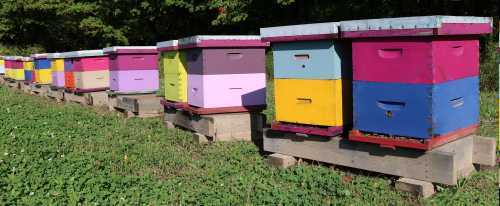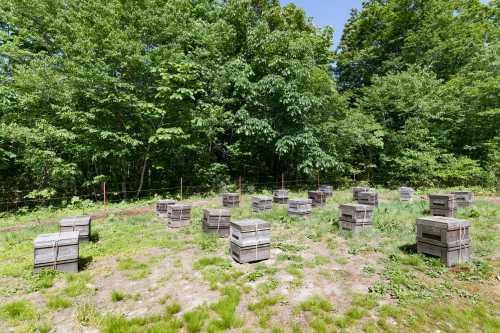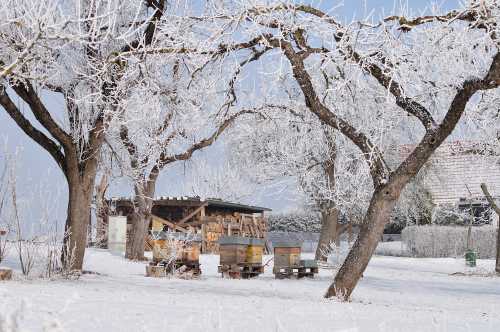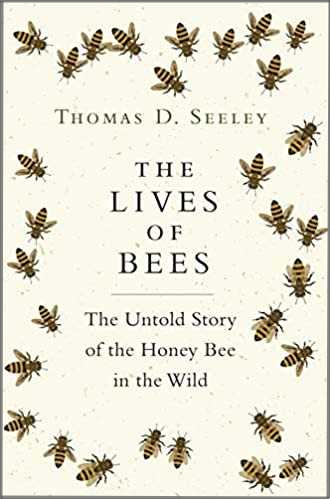Apiary Design
Your apiary will very much depend on your own circumstances and your local environment. Here are several points to consider, whether you wish to have an apiary as a business or a new hobby.
8 Factors To Consider In Apiary Design
1. Sustainability
It would be a mistake to attempt to keep an apiary
consisting of many hives, if there is little available to the bees in terms of
nectar and pollen.
2. Nectar and pollen
Bees need to gather food (nectar and pollen) from flowering plants, trees and shrubs. If you have a lot of land that can be filled with nectar and pollen rich
plants, then you may be less concerned about provision of resources in the wider environment.
Failing that, it's best to inspect the local area thoroughly. What might be
available to the bees from gardens, parks, trees and hedgerows through the
seasons?
Remember that the local flora will affect the taste and
quality of any honey produced.
3. Access to water
Bees will need water,
and ideally, there will be adequate supply close by, in the form of a garden
pond with a 'beach' area, or other water in the area. Even a bird
bath containing pebbles for to land on is useful to bees.
4. Local environment risk
Do agricultural practices in your area represent a risk to the bees, for
example, from chemical poisoning?
5. Shelter
Adequate shelter from the elements will help protect your hives and bees,
especially from winter gales. Positioning the hives against a high hedge,
sturdy fence or wind break, whilst ensuring the hive entrance faces away from prevailing
winds, will provide good protection.
Avoid low ground and areas where
cold air accumulates and where you are likely to experience pockets of frost. Depending on where you live, your hives may also need shelter from extreme heat, and in such cases a little shade will be welcome for part of the day.
6. Avoid hazards from above
Falling tree branches and unstable structures could damage hives in the event
of a gale or accident. Site your hives away from such dangers.
Persistent dripping water from buildings or trees could also ultimately weaken
the hive.
7. Space
Ensure plenty of space between your hives so that you can easily walk around
them with your equipment, as well as remove supers or frames.
Some beekeepers prefer to have greater space between hives to help prevent the spread of some diseases and parasites from one colony to another, by bees accidentally flying into the wrong hive.
8. Community relations
If you have difficult people living next door, you may want to think twice
about keeping bees in your garden.
They may have legitimate concerns
about bees (especially swarming), especially if they have young children, pets
or allergies to bee stings. It would be a shame to invest time and money
in equipment and nucs only to find you are forced to get rid of it all.
You should also check local regulations with regard to setting up an apiary.
Apiary images
Here's an ad-hoc selection of images of apiaries, each with a different design.
 This beekeeper has arranged his hives in twos. Hives have been paired close together, with a little space to walk around one side of each hive.
This beekeeper has arranged his hives in twos. Hives have been paired close together, with a little space to walk around one side of each hive. The opposite arrangement from the apiary above, this beekeeper prefers to leave plenty of space between each single hive.
The opposite arrangement from the apiary above, this beekeeper prefers to leave plenty of space between each single hive. These hives are well spaced, but perhaps have slightly less space between them than shown in the apiary above. Paint may have been used as part of a record system.
These hives are well spaced, but perhaps have slightly less space between them than shown in the apiary above. Paint may have been used as part of a record system. A small apiary consisting of 3 hives.
A small apiary consisting of 3 hives.
Catchy And Fun Names For An Apiary
A name that is fun or catchy is often easier to remember, which may be relevant if you aim to start and apiary business. Here's a few names for an apiary that I came up with during a 5 minute brainstorm (please note, I haven't checked whether any of these names are already registered elsewhere):
- Queen's Treasure Apiary
- Queen's Gold Apiary
- Sweet Delight Apiary
- Flower And Bee Apiary
- Sweet Gold Apiary
- Liquid Gold Apiary
- Golden Delight Apiary
- Sweet Wonder Apiary
- Natural Treat Apiary
- Golden Palace Apiary
- Honey Gobblers' Apiary
- Bonnet Of Bees Apiary
- Mr/Mrs Sweet Tooth's Apiary
- Fuzzy Buzzy's Apiary
- Bee-Candy Apiary
- Buzzy Friends Apiary
- Beautiful Bees Apiary

